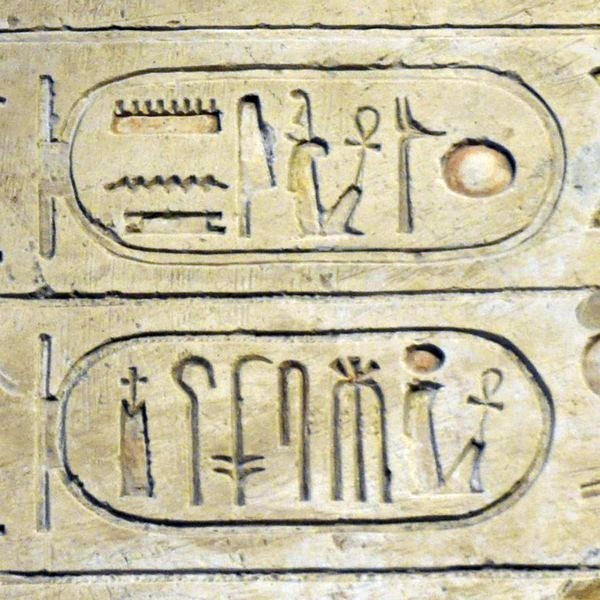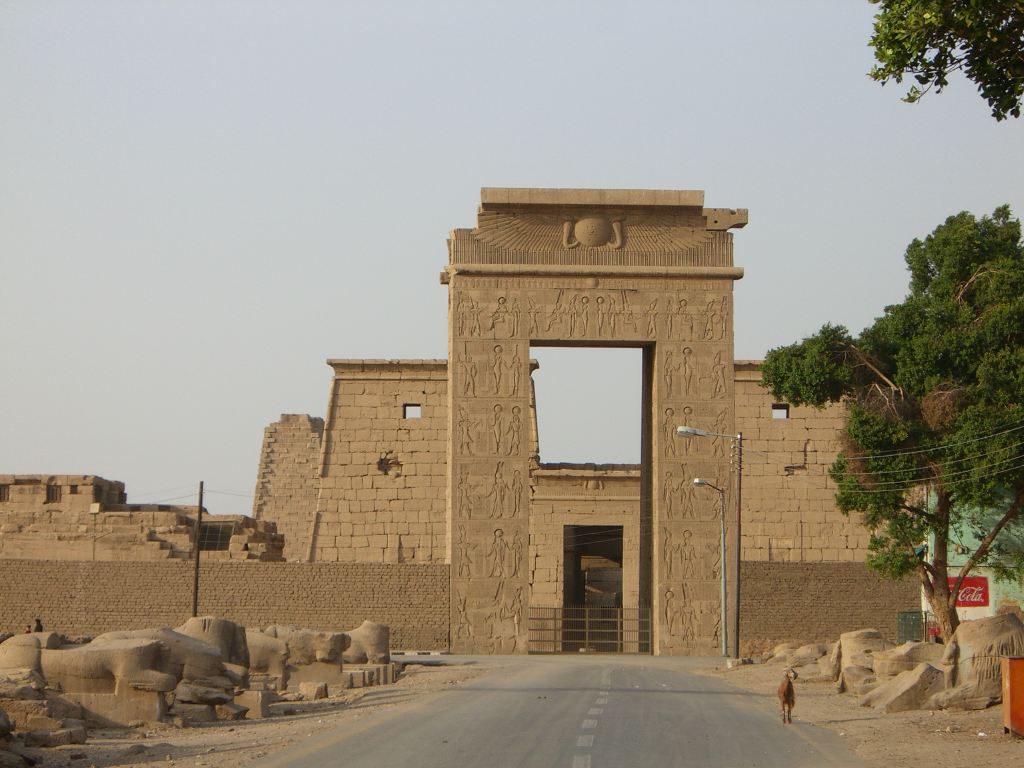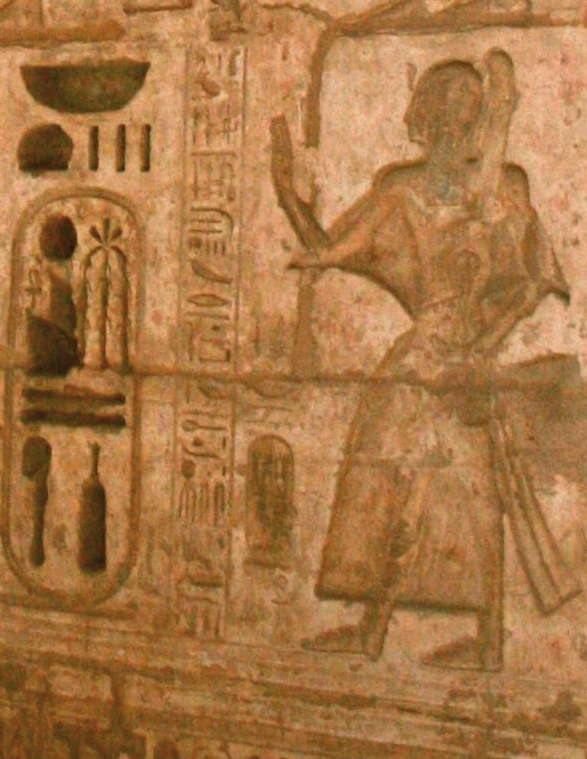|
Ramesses III
Usermaatre Meryamun Ramesses III was the second Pharaoh of the Twentieth dynasty of Egypt, Twentieth Dynasty in Ancient Egypt. Some scholars date his reign from 26 March 1186 to 15 April 1155 BC, and he is considered the last pharaoh of the New Kingdom of Egypt, New Kingdom to have wielded substantial power. His long reign saw the decline of Egyptian political and economic power, linked to a series of invasions and internal economic problems that also plagued pharaohs before him. This coincided with a decline in the cultural sphere of Ancient Egypt. However, his successful defense was able to slow down the decline, although it still meant that his successors would have a weaker military. He has also been described as a "warrior Pharaoh" due to his strong military strategies. He led the way by defeating the invaders known as "the Sea Peoples", who had caused destruction in other civilizations and empires. He was able to save Egypt from collapsing at the time when Late Bronze Age c ... [...More Info...] [...Related Items...] OR: [Wikipedia] [Google] [Baidu] |
Temple Of Khonsu
The Temple of Khonsu is an ancient Egyptian temple. It is located within the large Precinct of Amun-Re at Karnak, in Luxor, Egypt. The edifice is an example of an almost complete New Kingdom of Egypt, New Kingdom Egyptian temple, temple, and was originally constructed by Ramesses III on the site of an earlier temple. The gateway of this temple is at the end of the avenue of sphinxes that ran to the Luxor Temple. In Ptolemaic dynasty, Ptolemaic times, Ptolemy III Euergetes constructed a great gateway and enclosure wall for the temple; only the gateway now remains (see below). Inscriptions inside the forecourt of the temple were made in the time of Herihor. The hypostyle hall was erected by Nectanebo I and is not of great size; inside were found two Baboon, baboons that appear to have been carved in the time of Seti I. It probably belonged to the earlier building on the site. Numerous blocks with unmatched and inverted decorations can be seen, showing the amount of reconstruction an ... [...More Info...] [...Related Items...] OR: [Wikipedia] [Google] [Baidu] |
Pareherwenemef (20th Dynasty)
Pareherwenemef (“Re is with his left arm”) was an ancient Egyptian prince of the 20th Dynasty, a son of pharaoh Ramesses III. Just like several of his brothers, he was named after a son of Ramesses II, whom Ramesses III tried to emulate (see Pareherwenemef). He is depicted in his father's mortuary temple at Medinet Habu., p.194 Both he and his brother Khaemwaset Prince Khaemweset (also translated as Khamwese, Khaemwese or Khaemwaset or Setne Khamwas) (c. 1281 BCE - 1225 BCE) was the fourth son of Ramesses II and the second son by his queen Isetnofret. His contributions to Egyptian society were remembered ... are called firstborn sons of the king; they were possibly the firstborns of different wives.Dodson & Hilton, p.190 He was buried in QV42. Sources External links Theban Mapping Project– Plan of the tomb and other details. Ancient Egyptian princes People of the Twentieth Dynasty of Egypt Children of Ramesses III {{AncientEgypt-bio-stub ... [...More Info...] [...Related Items...] OR: [Wikipedia] [Google] [Baidu] |
Pharaoh
Pharaoh (, ; Egyptian language, Egyptian: ''wikt:pr ꜥꜣ, pr ꜥꜣ''; Meroitic language, Meroitic: 𐦲𐦤𐦧, ; Biblical Hebrew: ''Parʿō'') was the title of the monarch of ancient Egypt from the First Dynasty of Egypt, First Dynasty () until the Roman Egypt, annexation of Egypt by the Roman Republic in 30 BCE. However, the equivalent Egyptian language, Egyptian word for "king" was the term used most frequently by the ancient Egyptians for their monarchs, regardless of gender, through the middle of the Eighteenth Dynasty during the New Kingdom of Egypt, New Kingdom. The earliest confirmed instances of "pharaoh" used contemporaneously for a ruler were a letter to Akhenaten (reigned –1336 BCE) or an inscription possibly referring to Thutmose III (–1425 BCE). In the early dynasties, ancient Egyptian kings had as many as ancient Egyptian royal titulary, three titles: the Horus name, Horus, the prenomen (Ancient Egypt), Sedge and Bee (wikt:nswt-bjtj, ''nswt-bjtj''), and ... [...More Info...] [...Related Items...] OR: [Wikipedia] [Google] [Baidu] |
Medinet Habu
Medinet Habu (; ; ; ) is an archaeological locality situated near the foot of the Theban Hills on the West Bank of the River Nile opposite the modern city of Luxor, Egypt. Although other structures are located within the area and important discoveries have also been made at these sites, the location is today associated almost synonymously with the largest and best preserved site, the Mortuary Temple of Ramesses III. It was an important New Kingdom period temple structure in the West Bank of Luxor in Egypt. Aside from its size and architectural and artistic importance, the mortuary temple is probably best known as the source of inscribed reliefs depicting the advent and defeat of the "sea peoples" during the reign of Ramesses III (c. 1186–1155 BC), including the Battle of the Delta. Some of the building materials were re-used from earlier monuments including the destroyed mortuary temple of Tausret (c. 1191–1189 BC) the last known ruler and the final pharaoh of the Nineteen ... [...More Info...] [...Related Items...] OR: [Wikipedia] [Google] [Baidu] |
Royal Cache
The Royal Cache, technically known as TT320 (previously referred to as DB320), is an Ancient Egyptian Hypogeum, tomb located next to Deir el-Bahari, in the Theban Necropolis, opposite the modern city of Luxor. It contains an extraordinary collection of mummified remains and funeral equipment of more than 50 kings, queens, and other royal family members of the New Kingdom of Egypt, New Kingdom, as it was used as a cache for royal mummies during the Twenty-first Dynasty of Egypt, Twenty-first Dynasty. The tomb was originally used as the last resting place of High Priest of Amun Pinedjem II, his wife Neskhons, and other close family members. Its discovery by locals between 1860 and 1871, and by Egyptologists in 1881, caused a sensation. The mummies quickly became a highlight of the new Egyptian Museum (then in Giza). In 1969, the discovery was dramatized in ''The Night of Counting the Years'', which became one of Egypt's most widely respected films. In 2021 the mummies were moved to ... [...More Info...] [...Related Items...] OR: [Wikipedia] [Google] [Baidu] |
Deir El-Bahri
Deir el-Bahari or Dayr al-Bahri (, , ) is a complex of mortuary temples and tombs located on the west bank of the Nile, opposite the city of Luxor, Egypt. This is a part of the Theban Necropolis. History Deir el-Bahari, located on the west bank of the Nile at Thebes, Egypt, Thebes (modern Luxor) is a complex of mortuary temples and tombs that has served as a major religious center for over two millennia. Its history begins with the 11th Dynasty when Pharaoh Mentuhotep II (c.2061-2010 BCE) constructed his funerary temple here to commemorate the reunification of Egypt after the First Intermediate Period. Mentuhotep's terraced complex, integrating a royal tomb into a temple platform, pioneered the cliffside temple style later emulated by New Kingdom rulers. Centuries later, the 18th Dynasty queen Hatshepsut erected her famous temple ''Djeser-Djeseru,'' designed by her architect Senenmut, directly beside Mentuhotep's complex. Richly decorated reliefs in Hatshepsut's temple celebr ... [...More Info...] [...Related Items...] OR: [Wikipedia] [Google] [Baidu] |
KV11
Tomb KV11 is the tomb of Pharaoh Ramesses III. It is located in the main valley of the Valley of the Kings. The tomb was originally started by Setnakhte, but abandoned when it unintentionally broke into the earlier tomb of Amenmesse ( KV10). Setnakhte was buried in KV14. The tomb KV11 was later restarted and extended and on a different axis for Ramesses III. The tomb has been open since antiquity, and has been known variously as "Bruce's Tomb" (named after James Bruce who entered the tomb in 1768) and the "Harper's Tomb" (due to paintings of two blind harpers in the tomb). Decoration The long tomb is beautifully decorated. The second corridor is decorated with the '' Litany of Re''. At the end of this corridor the axis of the tomb shifts. This third corridor is decorated with the ''Book of Gates'' and the '' Book of Amduat'', and leads over a ritual shaft, and then into a four-pillared hall. This hall is again decorated with the ''Book of Gates.'' A fourth corridor decorated w ... [...More Info...] [...Related Items...] OR: [Wikipedia] [Google] [Baidu] |
Tiy-Merenese
Tiy-Merenese,J. Tyldesley, Chronicle of the Queens of Egypt, 2006, Thames & Hudson Teye-Merenaset,Grajetski, Ancient Egyptian Queens: a hieroglyphic dictionary, Golden House Publications Tiye-MerenisetAidan Dodson & Dyan Hilton, The Complete Royal Families of Ancient Egypt, Thames & Hudson (2004) ''(Tiy, Beloved of Isis)'' was the Great Royal Wife of pharaoh Setnakhte and mother of Ramesses III of the Twentieth Dynasty of Egypt. She is the only known wife of Setnakhte. She was depicted together with her husband on a stela A stele ( ) or stela ( )The plural in English is sometimes stelai ( ) based on direct transliteration of the Greek, sometimes stelae or stelæ ( ) based on the inflection of Greek nouns in Latin, and sometimes anglicized to steles ( ) or stela ... in Abydos. A priest named Meresyotef is shown adoring Setnakhte and Tiy-Merenese and their son Ramesses III is shown making offerings. Tiye-Merenese also appears on blocks found in Abydos which were reused in ... [...More Info...] [...Related Items...] OR: [Wikipedia] [Google] [Baidu] |
Duatentopet
Duatentopet or Tentopet (fl. 1150 BCE) was an ancient Egyptian queen of the 20th Dynasty, the wife of Pharaoh Ramesses IV, and mother of Ramesses V. Even though the identity of Ramesses IV's wife has not been clearly stated in history, she is considered the most likely candidate by virtue of the titles she was given and which were found listed in her tomb (QV74). In the Karnak Temple Complex, an Adoratrix named Tentopet is shown with Ramesses III in the Temple of Khonsu The Temple of Khonsu is an ancient Egyptian temple. It is located within the large Precinct of Amun-Re at Karnak, in Luxor, Egypt. The edifice is an example of an almost complete New Kingdom of Egypt, New Kingdom Egyptian temple, temple, and was o .... It is thought likely that Tentopet and Queen Duatentopet were the same person, and that she was a daughter of Ramesses III. This would make her a sister, or a half-sister, of her husband. Her steward Amenhotep was buried in Theban tomb TT346.Dodson & Hilton, p. ... [...More Info...] [...Related Items...] OR: [Wikipedia] [Google] [Baidu] |
Ramesses VIII
Usermaatre Akhenamun Ramesses VIII (also written Ramses and Rameses) or Ramesses Sethherkhepshef Meryamun ('Set is his Strength, beloved of Amun') (reigned 1130–1129 BC, or 1130 BC), was the seventh Pharaoh of the Twentieth Dynasty of the New Kingdom of Egypt, and was the 9th of the 10 sons of Ramesses III. Before ascending to the throne, he was simply known as Prince Sethherkhepsef II. Reign Ramesses VIII is the most obscure ruler of the 20th Dynasty, and the current information from his brief kingship suggests that he lasted on the throne for one year at the most. The fact that he succeeded to power after the death of Ramesses VII —his half-nephew and a son of Ramesses VI—may indicate a continuing problem in the royal succession.Clayton, p.169 Similar to Ramesses IV and Ramesses VI, Ramesses VIII was also a son of pharaoh Ramesses III. Ramesses VIII's Prenomen, Usermaatre Akhenamun, means "Powerful is the maat of Ra, Effective for Amun." Monuments from his reign ... [...More Info...] [...Related Items...] OR: [Wikipedia] [Google] [Baidu] |
Meryatum (20th Dynasty)
Meryatum (“Beloved of Atum”) was an ancient Egyptian prince and High Priest of Re, the son of Pharaoh Ramesses III. Meryatum was the brother of pharaohs Ramesses IV, Ramesses VI, and Ramesses VIII. He was the uncle of pharaohs Ramesses V and Ramesses VII. His name can also be found as ''Ramesses Meryatum.'', p.193 Meryatum is shown in the procession of royal sons depicted in Medinet Habu. He lived at least into the reigns of Ramesses IV and Ramesses V. Meryatum is mentioned in Wilbour Papyrus. See also * Meryatum, the son of Ramesses II Ramesses II (sometimes written Ramses or Rameses) (; , , ; ), commonly known as Ramesses the Great, was an Pharaoh, Egyptian pharaoh. He was the third ruler of the Nineteenth Dynasty of Egypt, Nineteenth Dynasty. Along with Thutmose III of th ... References Ancient Egyptian princes High priests of Re People of the Twentieth Dynasty of Egypt Children of Ramesses III {{AncientEgypt-bio-stub ... [...More Info...] [...Related Items...] OR: [Wikipedia] [Google] [Baidu] |
Pentawere
Pentawer (also Pentawere and Pentaweret) was an ancient Egyptian prince of the 20th Dynasty, a son of Pharaoh Ramesses III and his secondary wife, Tiye., p.193 He was involved in the so-called " harem conspiracy", a plot to kill his father and place him on the throne. The details of his trial are recorded in the Judicial Papyrus of Turin; he committed suicide following his trial. A candidate for his body is a mummy known as "Unknown Man E", discovered in the Deir el-Bahari cache in 1881. This mummy is unusual as it was found wrapped in a sheep or goat skin and was improperly mummified, being left with all his organs. Bob Brier has suggested that this mummy does indeed belong to the disgraced prince; DNA analysis has confirmed a father-son relationship with Pentawer's known father, Ramesses III, with both sharing the same Y chromosomal haplogroup and half of their DNA. Conspiracy The actual name of this prince is unknown, "Pentawer" being a pseudonym given to him on the Judici ... [...More Info...] [...Related Items...] OR: [Wikipedia] [Google] [Baidu] |





